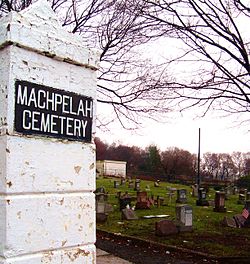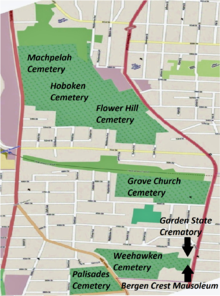| Machpelah Cemetery | |
|---|---|
 Near the front entrance along Tonnelle Avenue | |
|
| |
| Details | |
| Established | 1850 |
| Location | |
| Country | United States |
| Coordinates | 40°47′17″N 74°01′31″W / 40.7881566°N 74.0251401°W |
| Size | 10 acres (40,000 m2) |
| Website | Hudson Crematory and Cemetery |
| Find a Grave | Machpelah Cemetery |
The Machpelah Cemetery, also spelled as "Macpelah Cemetery", [1] [2] or "Macphelah Cemetery", [3] is a cemetery in Hudson County, New Jersey. [2]
Location

Machpelah Cemetery is located at 5810 Tonnelle Avenue, in North Bergen, New Jersey. [4] It is one of several burial sites along the western slope of the Hudson Palisades, which rise to the east 220 to 260 feet (67 to 79 m) above sea-level, [5] including the adjacent Hoboken Cemetery, and nearby Grove Church Cemetery, Weehawken Cemetery, [6] and Flower Hill Cemetery, [7] which together constitute a string of green open spaces in North Hudson County. [8] The entrance is just north of the Tonnelle Avenue terminus of the Hudson Bergen Light Rail.
History
Name
Machpelah is a name given to numerous cemeteries in the United States. The Cave of the Patriarchs or the Cave of Machpelah ( Hebrew: מערת המכפלה, Me'arat HaMachpela, Trans. "Doubled Cave") is a cave-within-a-cave located in Hebron that Biblical tradition ascribes the status of the burial tomb for Abraham, Isaac, Jacob, and their wives.
Before the cemetery

Machpelah is contained within Lot No. 18 in then Maisland, which contained a celebrated and exotic garden, locally called the "Frenchman's Garden", [9] since the well-known botanist André Michaux was commissioned by the King of France, Louis XVI in 1786 as a botanist with the ability to import any plant, tree or vegetable from France that was desired by the United States. It also featured a variety of plants collected from the United States, as well as plants from all over the world. [9] It was enclosed in a stone wall, roughly 30 acres (120,000 m2) and kept by the gardener Pierre-Paul Saunier. [10] The Lombardy poplar was originally stocked in the garden, and, introduced into commerce, eventually spread throughout the United States. [11]
Use as a burial site
Located in the Bergenwood section of then New Durham, [1] land at Machpelah Cemetery was first used for burial purposes in 1850. [5] The cemetery was officially opened in 1853, by the Third Reformed Presbyterian Church Society of New York, and thus, was for many years strictly Protestant Cemetery. This is controversial and disputed by many. Other sources list it strictly as a Jewish burial site and claim the misinformation on Protestant ownership was due to the widespread anti semitism and attempt by the Protestant Church in New York to convert all Jews to Christianity. The Protestant missionary movement in the 1800s to convert "was reported regularly in The New York Times newspaper. [12] In the Twenty Seventh edition of Appleton's Dictionary dated 1905, listed in alphabetical order just above the description of Madison Square Garden, it discusses Machpelah Cemetery being strictly a Jewish Cemetery. It makes no mention of a Protestant cemetery being in use on the same grounds or being shared. Rather Appleton's Dictionary explains it is a Jewish Cemetery in addition to a 2nd Jewish Cemetery of the same name in Queens New York. Overall, the grounds at Machpelah cemetery are approximately 10 acres (40,000 m2). [13] Because of the steep grade of the grounds and the eventual descent into the surrounding marshes in Secaucus, contamination of wells, springs, and water-courses in the surrounding area is very low. [5]
A report from 1879 states that 2,500 graves lie in the cemetery, where the price of a grave annually was about $100, [5] and in the next century it was reported to have over 18,000 bodies in it. [14]
In 1900, many who died in the massive fire on the Hoboken piers the SS Saale, [15] and SS Bremen on the North River (Hudson River) were interred at the cemetery and the adjacent Flower Hill in gravesites purchased by the shipping company. [16] [17]
In 2022, Hudson County and volunteers embarked on program to restore gravestones of over 300 veterans buried at the cemetery. [18]
See also
References
- ^ a b Leonard, p. 51.
- ^ a b "Macphelah Cemetery". Placenames. Archived from the original on 25 February 2012. Retrieved 21 September 2010.
- ^ Rieser, p. 34.
- ^ Inskeep, p. 229.
- ^ a b c d National Board of Health, p. 202
- ^ National Board of Health, p. 201.
- ^ "Hoboken Cemetery". Graveinfo. 2002–2010. Retrieved 21 September 2010.
- ^ Hagstrom Map, Hudson County.
- ^ a b Winfield, p. 323.
- ^ New York Botanical Garden, p. 106.
- ^ Winfield, p. 324.
- ^ TimesMachine May 2, 1853
- ^ State Dept. of Health, p. 234.
- ^ Leonard, p. 52.
- ^ "Stone Quays is Hokoken; The North German Lloyd Company to Rebuild at Once. The Saale is Pumped Dry Tons of Decomposed Provisions Removed from Hold – Search for Bodies Awaits Removal of Debris" (PDF). The New York Times. 1900-07-14.
- ^ "Ready to Raise the Saale Three More Bodies Found on the Burned Steamship" (PDF), The New York Times, July 11, 1900, retrieved 2011-08-31
- ^ "New Way to Get a Wife; Barney Isaacs, Confronted with Mrs. Simons's Rejection, Moves, Her Furniture Into Another Flat" (PDF). The New York Times. 1900-07-20.
- ^ "Forgotten no longer: Veterans' graves in North Bergen cemetery are being restored". 20 May 2022.
Sources
- "The American missionary". Congregational Home Missionary Society. 35. American Missionary Association: 232. 1881. ISSN 1079-9044. OCLC 1480434.
- Appleton, D. (1902). "Appleton's dictionary of New York and vicinity". D. Appleton & Co. V: 353. OCLC 604901070.
- Hudson County New Jersey Street Map. Hagstrom Map Company, Inc. 2008. ISBN 978-0880977630.
- Inskeep, Carolee (1998). "New York City Metropolitan Area Cemeteries". The graveyard shift: a family historian's guide to New York City cemeteries. Ancestry Publishing. p. 296. ISBN 0916489892.
- Leonard, J. H. (1901). The Leonard Manual of the Cemeteries of New York and Vicinity. BiblioBazaar, LLC. p. 148. ISBN 1115044591.
- National Board of Health (1879). "Cemeteries and Burials". Annual report of the National Board of Health, 1879–1885. Government Printing Office. p. 477.
- State Dept. of Health, New Jersey. Board of Health (1898). "Annual report". New Jersey. Board of Health: 392. OCLC 1759842.
- Garden Journal. 7–8. New York Botanical Garden. 1957.
ISSN
0016-4585.
OCLC
1570422.
{{ cite journal}}: Missing or empty|title=( help) - Rieser, Robert (1915). "Hudson County to-day: Hudson County, New Jersey; its history, people, trades, commerce, institutions and industries". Hudson Dispatch: 162.
OCLC
35906879.
{{ cite journal}}: Cite journal requires|journal=( help) - Winfield, Charles Hardenburg (1874). "History of the county of Hudson, New Jersey: from its earliest settlement to the present time". Kennard & Hay Stationery M'fg and Print. Co: 568.
OCLC
426912.
{{ cite journal}}: Cite journal requires|journal=( help)
External links
- Aerial view of Hoboken, Machpelah, and Flower Hill at Graveinfo
- Machpelah Cemetery at Find a Grave
- Civil War Gravestones at Machpelah at New Jersey Civil War Gravestones